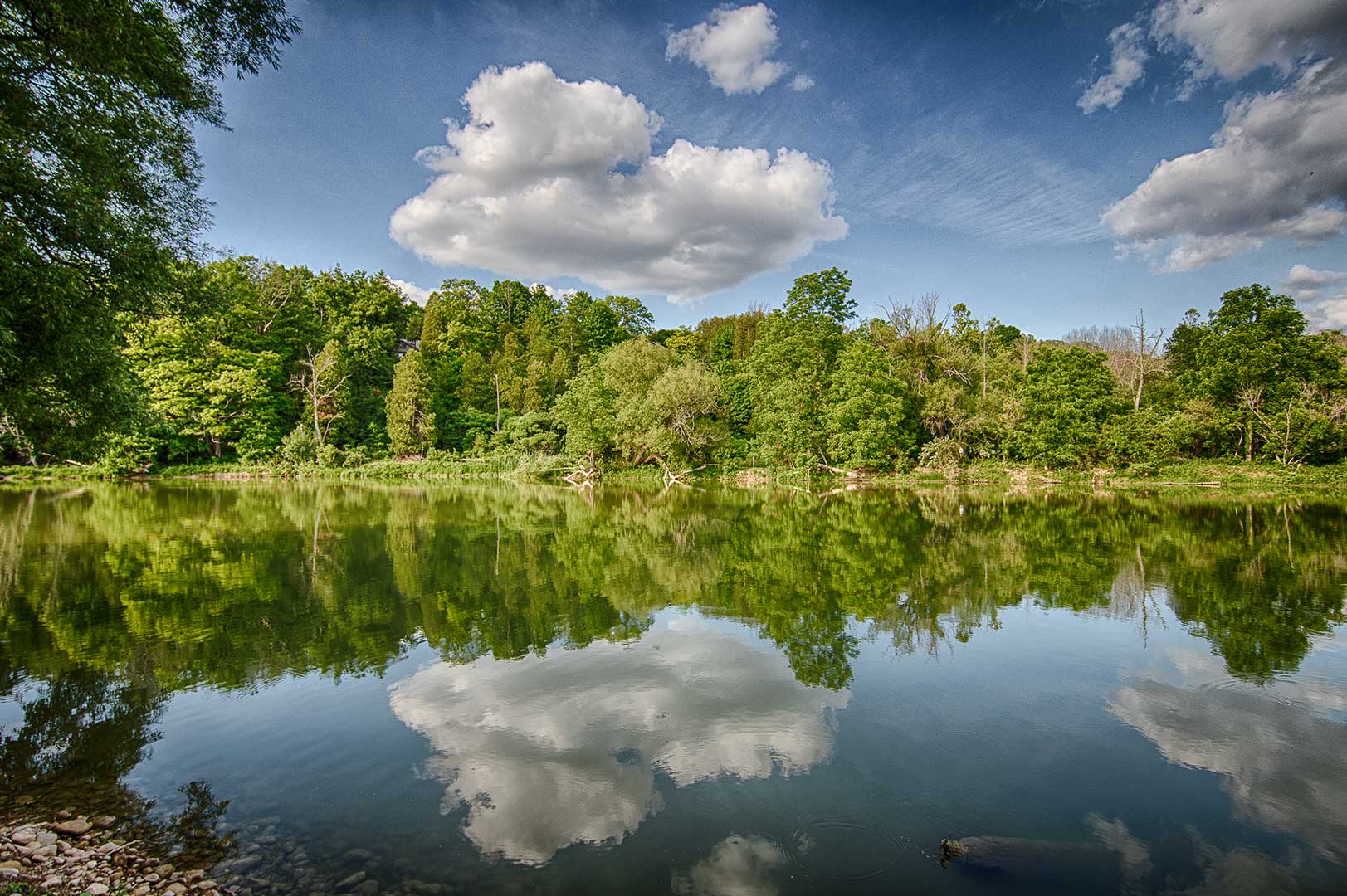Roadmap to Net-Zero
Our ChallengesLand and Nature
#ClimateActionNow
Local food. Natural space. Water. Diverse ecosystems and wildlife.
These are only a few of the amazing things Ontario’s natural heritage provides.
Ontario’s wetlands, forests and watersheds are some of our best natural solutions to address the climate crisis.
Wetlands help filter our water and prevent flooding.
Forests protect soil and water, offer habitat and store carbon.
And nature is essential for our own wellbeing.
Protecting our natural heritage will enrich biodiversity that directly affects some of our most important economic sectors: forestry, food and farming.
Now is the time to strengthen protections for the places we love, the natural heritage we celebrate, and the food and water resources that sustain us. To protect the land and nature of Ontarians, the province must protect and restore natural areas and functions, in partnership with Indigenous Peoples.
Key metrics for land and nature will include:
- Usable public open space.
- Connected protected areas.
- Biodiversity: area and condition of key habitats.
- Urban tree cover.
- Soil health.
- The ratio of green to gray infrastructure.
Ontario Greens’ key policies for protecting and restoring land and nature will include:

Biodiversity (Plants and animals)
- Strengthen protection for endangered species:
- Restore the original (Endangered Species Act, 2007) science-based system for determining species status.
- Ensure that economic development activities respect species’ tolerance limits for habitat disturbance.
- Remove exemptions that allow forestry, mining etc. to damage species and their habitat.
- Properly resource endangered species recovery efforts and habitat stewardship programs.
- Restore public accountability and reporting on endangered species status and recovery.
- Bring back prescribed and Indigenous planned forest burns that reduce the risk of out-of-control wildfires and create habitat.
- Protect pollinators by ending the outdoor use of neonicotinoid pesticides and restricting other pesticides.
- Restore the pesticides classification system and the pesticides advisory committee.
- Regulate new outdoor lighting to include dark sky protection.
Environmental assessment (EA)
Restore a robust EA process.
- Restore automatic environmental assessment of public-sector projects, plans and policies, including timber management on Crown lands and regional assessments.
- Include private sector projects that will have long term environmental impacts, including mining and smelters.
- Consider the cumulative effects of projects on landscapes, ecosystems and health.
- Ensure that EAs evaluate the need for a project, and alternatives to building the project, not just how and where to build the project, (except for urgent infrastructure needed to implement this plan, such as transit, active transportation, electricity and electrification.)
- Ensure all assessments consider climate impacts and mitigation (i.e. GHG emission reductions,) and are consistent with Ontario’s Fair Share Carbon Budget.
Strengthen public consultation requirements.
Including restoration of intervenor funding, uphold the duty to consult First Nations, and improving planning and notice requirements for some activities covered by Class EAs.
Participate in the federal Regional Assessment for the Ring of Fire.
Provide First Nations communities with support, capacity funding, and flexibility in timelines in order to consider cumulative effects, at multiple scales, as they engage with government and proponents on industrial development, particularly for communities living near and downstream of the Ring of Fire.

Protected areas
Reinvest in provincial parks and nature reserves.
- Protect and enhance provincial parks.
- Strengthen and fund the ecological integrity role of the public parks system.
- Monitor to ensure our parks are meeting both ecological and visitor objectives and will be there for our grandkids.
- Stop sales of parkland.
Expand the Greenbelt.
Add into the Greenbelt the prime agricultural land, provincially significant wetlands, and other areas of ecological significance between the Greater Golden Horseshoe Area and the existing Greenbelt.
Work with Indigenous Peoples.
With the goal of permanently protecting natural ecosystems in 25% of Ontario by 2025 and 30% of Ontario by 2030.
- Recognize and support Indigenous protected and conserved areas, as declared by Indigenous Peoples, in priority to extractive industries such as forestry and mining.
- Fund stewardship of these lands and waters by Indigenous guardians.
- Give priority to protecting biodiversity hotspots, carbon hotspots such as peatlands, grasslands, old growth forests, and connectivity between protected areas.
- Include habitat for endangered species based on a robust, science-based system without exemptions for forestry or mining.

Protect biodiversity
- Effectively monitor the health of Ontario’s natural areas and species so we can protect them.
- Restore and regenerate wetlands and woodlands, re-plant native trees and regrow forests.
- Really protect areas designated as protected, e.g. stop logging in Algonquin Park.
- Re-establish a public seed bank of heritage crops and native trees and plants.
Strengthen and fund Conservation Authorities (CA).
- Restore the full authority and capacity of Conservation Authorities to protect the health of watersheds and those who live in them.
- Rapidly repeal all conservative government changes to Conservation Authorities’ funding and authority.
- Revoke, without compensation, all Conservation Authorities’ permits issued because the CA was compelled to do so by a Ministerial Zoning Order (MZO).
- Re-establish open, transparent, evidence and rules-based approaches to decision-making.
- Provide public access to view CA permits, and a public right of appeal.
- Provide stable provincial funding for their full mandates, including water and erosion control, invasive species management, and forestry.
- Expand Conservation Authorities’ jurisdiction to include all major public and private activities that damage the ecological integrity of natural heritage areas, including public and private agriculture, drainage, aggregates, and infrastructure.
- Confirm that the Conservation Authorities Act binds the Crown.

Nature-based solutions
- Bring back nature in cities, starting with green roofs, school yards, and turning surplus parking lots in tree deserts into mini-forests.
- Provide matching funds for municipalities to plant trees and other native plants in areas where low-income residents suffer the most from heat and lack of greenspace.
- Establish a centre of excellence for urban forestry.
- See also Improve access to nature and greenspace.
- Create a “green infrastructure first” policy, using nature-based solutions to provide ecosystem services whenever possible.
- Earmark at least 15% of infrastructure spending for green infrastructure — meaning living plants and soil, not concrete.
- Establish a dedicated $200 million green infrastructure fund to allow for long-term planning, delivery, and maintenance of projects (e.g. storm water management, parks infrastructure, natural heritage systems protection, invasive species detection and management, forest management, habitat enhancement and creation.)
- Develop a Green Infrastructure Support Hub to provide municipalities and practitioners with knowledge, technical expertise, resources and training to facilitate capacity building, rapid uptake and effective installations.
- Make ecocide (massive, deliberate destruction of nature) a legal offence.
- Protect and restore natural areas that sequester carbon, including grasslands and peatlands and improve forest management.